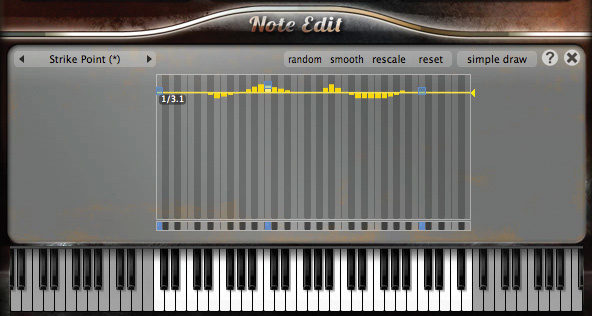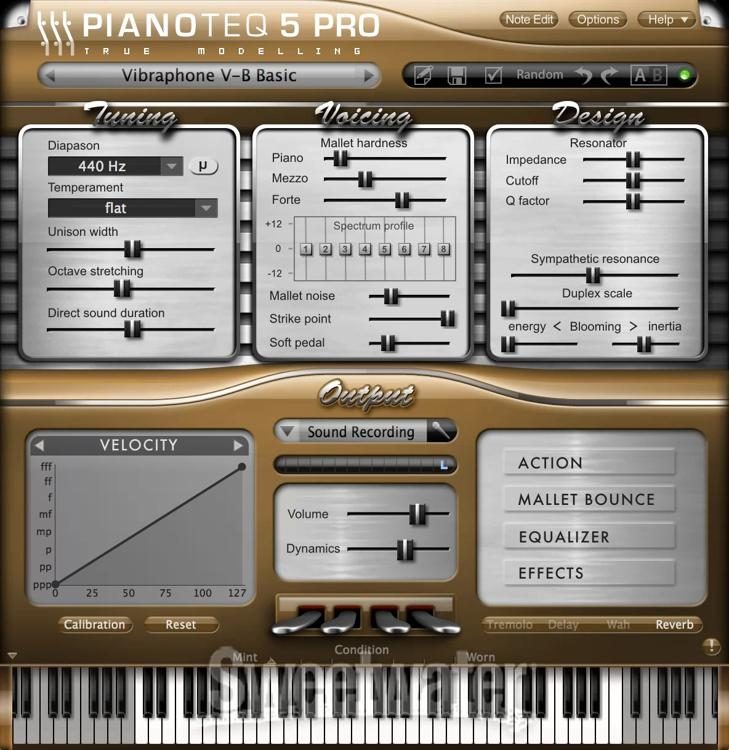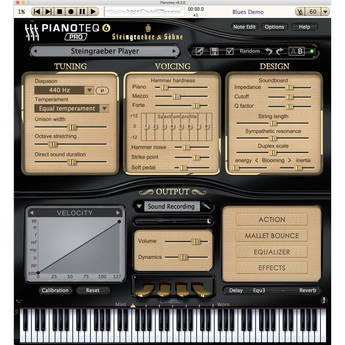

New grand piano modelled after a New York Steinway Model D All pianos in Pianoteq 7 are constructed and revoiced using this new physical model. It also allows longer sustain, particularly in the bass range, with notes lasting up to a couple of minutes, just like on a real acoustic piano. The new physical model allows more complex tones to be produced, and as observed by a pianist, the sound becomes "three-dimensional". parallel or perpendicular to the soundboard. It consists in modelling string vibrations that can take any direction, e.g. Modartt introduces a new refinement in its physical model: the double polarization. Listen to audio demos Refined physical model

The difference between Morphing and Layering is that in the latter the two sounds are mixed together, whereas in Morphing the instrument Physics itself is being morphed. playing Bass Marimba in the low range, Xylophone in the upper range and mixing both together in the middle range. On popular demand, Modartt adds a new layering feature in Pianoteq 7 (Standard/PRO) allowing to mix several instruments, e.g.

This innovative technology handles the morphing at the physical modelling level, providing stunning acoustic authenticity to instruments that never existed. These are however three of the many instruments you can create with the acoustic Morphing introduced in Pianoteq 7 (Standard/PRO). The instruments XyloHarp, VibraDrum or GlockenTines certainly do not exist. Since the Celeste Pedal is continuous, it lets you adjust the thickness of the felt. It is based on the improved Celeste Pedal which makes use of a virtual felt strip that is interposed between hammers and strings to achieve a softer, and more delicate, sound. What's new in version 7 Felt presets with improved Celeste Pedal (available as from version 7.4)Ī new ‘Felt’ preset is added to all contemporary pianos. Up to 48 kHz in PIANOTEQ Stage and Standard.
Pianoteq 5 tpb pro#
PIANOTEQ PRO offers an internal sample rate of up to 192 kHz. Presets built with PIANOTEQ PRO can be loaded in PIANOTEQ Standard without limitation. In PIANOTEQ Stage, preset loading is limited to parameters that are present in the interface. You can purchase additional instrument packs at any time. These instrument packs are fully working whereas remaining instrument packs are available in demo mode for your evaluation. During registration, you can choose two instrument packs with the Stage version, three with the Standard version and four with the PRO version. Note-per-note edit: all other physical parametersĬoncerns new purchases from 2019 onward. Dithering added to the audio export in Pianoteq Standalone.Note-per-note edit: volume, detune, attack envelope.Pianoteq presets (FXP files) can now embed a short MIDI excerpt.Improved key noises, with an optional humanization of the parameters.The four pedals of the interface can be re-assigned to a few parameters such as Rattle, Lute Stop, Celeste, Super Sostenuto.The polarity of a microphone can be reversed (for M/S recording situations, typically).Microphones can be linked together, and then moved or rotated together.Many microphone models, with various directivity patterns, are available.Directional microphones support, which can be rotated in all directions.
Pianoteq 5 tpb free#
The free KIVIR instruments are still those of version 4, but we are working on them and a very improved version will be available soon.Nine new instruments: Grand K2 and the Kremsegg Collection.All instruments brought up-to-date with latest model improvements, D4 and YC5 re-built from scratch.Preview: for advanced users, Pianoteq can be remote controlled with a JSON-RPC api when started with the "-serve localhost:8081" option.Unsaved MIDI mappings can be restored from the midimapping menu, in options / MIDI.Metronome volume and speed are now MIDI controlable.Delay reduced when playing with the Celeste pedal at a very low velocity.Fixed sostenuto pedal when used with diatonic mode.(Standard & Pro) New temperament menu entry for importing the current MTS-ESP tuning as a Pianoteq tuning.External tuning now sounds much better when the amount of retuning applied to notes is large.External tuning can switch between continuous (sounding notes are re-pitched) and new notes only (sounding notes do not change).It is now possible to disable external tuning (MTS-ESP, MIDI tuning) in a preset.Added option for damping notes when the sustain pedal is pressed, either with low velocity note-on MIDI or aftertouch (option available in the velocity menu).Revoicing of NY Steinway D, HB Steinway D, Steinway B, Ant.


 0 kommentar(er)
0 kommentar(er)
